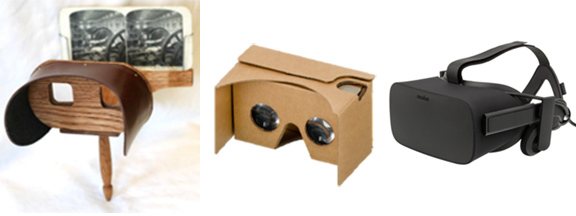Imagine students discovering concepts through exploration and honing skills through an immersive simulation experience.
At the end of October faculty and staff gathered at the Centre for Teaching Support & Innovation to attend a full capacity event to share and explore these emerging trends.
Developed by Diane Michaud and Laurie Harrison, this orientation workshop brought future looking instructors and educational technology support staff together to introduce the potential of AR (augmented reality) and VR (virtual reality) for teaching and learning.

Timeline of stereoscopic viewers to VR headsets. Images from L to R: Holmes_stereoscope_invented 1861_Photo by Davepape_Public Domain_Wikimedia, 2014: Google Cardboard VR headset_photo by Evan-Amos_Public Domain_Wikimedia, 2016: Oculus Rift CV1, photo by Evan-Amos, Public Domain, Wikimedia
The session was co-facilitated by several pioneering faculty members who presented their creative examples of the use of these technologies at the University of Toronto and beyond. Anesthesiology Professor, Dr. Fahad Alam presented his research team’s preliminary findings after sending out stereoscopic viewers for their ChildLife app featuring 360 videos that aim to reduce pre-procedure anxiety in patients coming to the Hospital for Sick Children. Johanna Carroll and Martina Steiner, Teaching Stream Professors in Molecular Genetics discussed their project using immersive virtual reality-based wet labs for students to view and experience via some of the latest wireless VR headsets. The final faculty demo was from Professor Dawn Kilkenny of the Institute of Biomaterials and Biomedical Engineering who described her project of creating custom virtual labs.
Participants were asked to consider how these technologies could serve their learning objectives for students or solve an instructional challenge. They were then able to discuss the applicability of extended reality technologies for specific course goals and explore related instructional design considerations. By the end of this session attendees were able to identify VR integration and development options, apply a practical framework for teaching and learning activity design ideas and begin to assess their own level of readiness for adoption of extended reality technology.

Dr. Chirag Variawa, Assistant Professor, Teaching Stream, Faculty of Applied Science and Engineering watching a 360 video on a mobile phone in a stereoscopic headset.
As a bonus, participants who arrived early were treated to a demo of VR and AR equipment and content. There were AR triggers for the ARchemy app created by Shadi Dalili, UTSC Chemistry Professor and a team of talented developers. Participants were able to try out a few VR headsets ranging from stereoscopic viewers for smartphones such as Google cardboard and a comfier plastic headset. A few folks tried out the fully immersive Lenovo daydream headsets with controllers to explore Labster’s virtual science labs. Those who demo’ed equipment were curious and enthusiastic, a reflection of the growing interest in the engaging learning possibilities of AR and VR and there was certainly an inspired buzz at this full-to-capacity workshop.
Full list of event facilitators:
- Laurie Harrison, Director, Digital Learning Innovation
- Diane Michaud, Instructional Technologies Liaison Librarian, UTM Library
- Dawn Kilkenny, Associate Professor, Teaching Stream, Institute of Biomaterials and Biomedical Engineering
- Fahad Alam, Assistant Professor, Anesthesia, Collaborative Human Immersive Interaction Lab (CHISIL)
- Johanna Carroll, Assistant Professor, Teaching Stream, Molecular Genetics
- Martina Steiner, Assistant Professor, Teaching Stream, Molecular Genetics
If you’re interested in connecting with peers exploring the use of AR and VR consider joining our network – https://onlinelearning.utoronto.ca/ar-vr-network/